PANASONIC DMCLC1EG, DMCLC1SG, DMCLC1GC User Manual
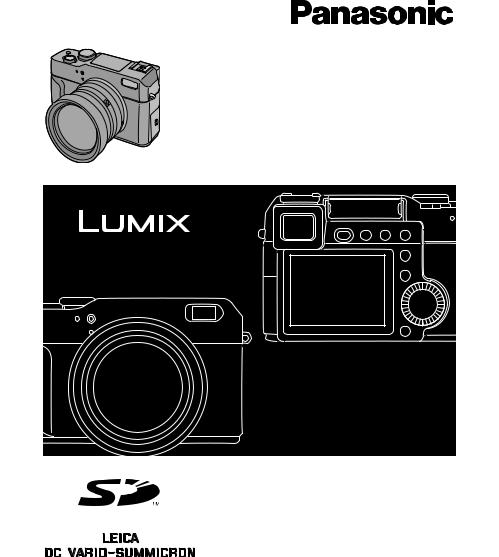
Digital Camera
Operating Instructions
Model No.DMC-LC1GC
DMC-LC1SG
Before use, please read these instructions completely.
VQT0G93

Safety
Dear Customer,
We would like to take this opportunity to thank you for purchasing this Panasonic Digital Camera. Please read these Operating Instructions carefully and keep them handy for future reference.
Information for Your Safety
WARNING
TO REDUCE THE RISK OF FIRE OR SHOCK HAZARD AND ANNOYING INTERFERENCE, USE ONLY THE RECOMMENDED ACCESSORIES AND DO NOT EXPOSE THIS EQUIPMENT TO RAIN OR MOISTURE. DO NOT REMOVE THE COVER (OR BACK); THERE ARE NO USER SERVICEABLE PARTS INSIDE. REFER SERVICING TO QUALIFIED SERVICE PERSONNEL.
Carefully observe copyright laws. Recording of pre-recorded tapes or discs or other published or broadcast material for purposes other than your own private use may infringe copyright laws. Even for the purpose of private use, recording of certain material may be restricted.
•Please note that the actual controls and components, menu items, etc. of your Digital Camera may look somewhat different from those shown in the illustrations in these Operating Instructions.
•SD Logo is a trademark.
•Other names, company names, and product names printed in these instructions are trademarks or registered trademarks of the companies concerned.
THE SOCKET OUTLET SHALL BE INSTALLED NEAR THE EQUIPMENT AND SHALL BE EASILY ACCESSIBLE.
CAUTION
Danger of explosion if battery is incorrectly replaced. Replace only with the same or equivalent type recommended by the manufacturer. Dispose of used batteries according to the manufacturer’s instructions.
Extremely high precision technology is employed to produce the LCD monitor/Viewfinder screen. The result is more than 99.99% effective pixels with a mere 0.01% of the pixels inactive or always lit. However, this is not a malfunction and does not affect the recorded pictures.
2
Contents |
|
Safety |
|
Information for Your Safety ................. |
2 |
Preparation |
|
Standard Accessories ......................... |
5 |
Names of the Components ................. |
7 |
Charging the Battery ........................... |
9 |
About the Battery .............................. |
10 |
Inserting the Battery .......................... |
11 |
Removing the Battery........................ |
12 |
Using the AC Adaptor ....................... |
13 |
About the Card .................................. |
14 |
Inserting the Card.............................. |
15 |
Removing the Card ........................... |
16 |
Attaching the MC Protector/Lens |
|
Cap/Lens Hood/Hood Cap ............ |
17 |
Attaching the Strap............................ |
19 |
Setting the Date/Time (Clock Set)..... |
20 |
Setup Menu....................................... |
22 |
Using the LCD Monitor/Viewfinder .... |
26 |
About the Histogram ......................... |
28 |
Operational Mode Dial and Metering |
|
Mode Dial ...................................... |
29 |
Setting the AE mode ......................... |
30 |
Shutter Speed and Aperture Value ... |
33 |
Recording pictures (basic) |
|
Taking Pictures with Auto Focus....... |
34 |
Taking Pictures |
|
with Manual Focus......................... |
40 |
Checking the Recorded Picture |
|
(Review) ........................................ |
42 |
Using the Optical Zoom..................... |
43 |
Taking Pictures |
|
using the Built-in Flash .................. |
44 |
Compensating the Exposure............. |
47 |
Taking Pictures |
|
using Auto Bracket ........................ |
48 |
Taking Pictures with the Self-timer.... |
49 |
Taking Pictures using Burst Mode .... |
50 |
Playback (basic) |
|
Playing Back Pictures........................ |
51 |
9 Pictures Multi Playback .................. |
53 |
Using the Playback Zoom ................. |
54 |
Deleting Pictures ............................... |
55 |
Recording pictures |
|
(advanced) |
|
Recording Motion Images ................. |
58 |
FUNCTION Menu.............................. |
60 |
Setting the White Balance ................. |
61 |
Setting the White Balance manually |
|
(White set) ..................................... |
63 |
Finely Adjusting the White Balance... |
64 |
Changing the Picture Size................. |
65 |
Changing the Quality......................... |
66 |
Taking Pictures using the Spot AF .... |
67 |
Setting ISO Sensitivity....................... |
68 |
Taking Pictures with Audio ................ |
69 |
Using the Digital Zoom ...................... |
70 |
Setting to the 2nd Curtain Synchro ... |
71 |
Adjusting the Quality of the Picture |
|
(Picture Adjustment) ...................... |
72 |
Creating Flip Animation ..................... |
73 |
Playback (advanced) |
|
Playing Back Pictures with Audio ...... |
76 |
Playing Back Motion Images ............. |
77 |
Rotating the Picture........................... |
78 |
Setting the Picture to be Printed and |
|
the Number of Prints |
|
(DPOF Print Setting)...................... |
79 |
Preventing Accidental Erasure of the |
|
Picture............................................ |
84 |
Playing Back with Slide Show ........... |
86 |
Adding Audio to Recorded Pictures |
|
(Audio Dubbing)............................. |
88 |
Resizing the Pictures......................... |
89 |
Trimming the Pictures ....................... |
91 |
Formatting the Card .......................... |
93 |
Playing Back Pictures |
|
with a TV Screen ........................... |
94 |
Before Connecting with USB |
|
Connection Cable .......................... |
95 |
3
Connecting to a PC |
|
(Mass Storage) .............................. |
97 |
Connecting to a PC (PTP)................. |
98 |
Connecting to a Printer ................... |
100 |
Using a Printer (PictBridge)............. |
101 |
Using a Printer (USB Direct-Print)... |
103 |
Others |
|
Using the External Flash ................. |
105 |
Using the Wide Conversion |
|
Lens/Close-up Lens..................... |
108 |
After Use ......................................... |
110 |
Screen Display ................................ |
111 |
The Menu Items .............................. |
113 |
Cautions for Use ............................. |
115 |
Approximate number of recordable |
|
pictures and the size.................... |
119 |
Message Display............................. |
120 |
Troubleshooting .............................. |
121 |
Specifications .................................. |
123 |
4
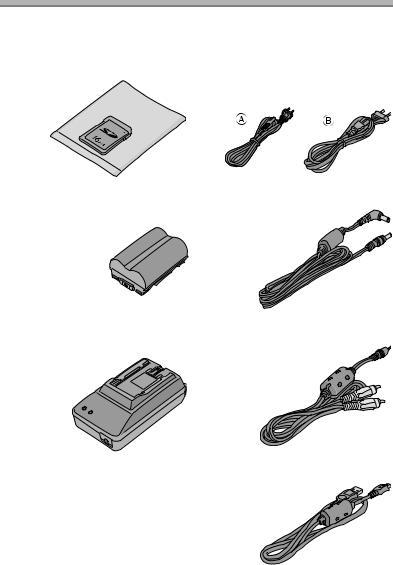
Preparation
Standard Accessories
Before using your camera, check the contents.
∫ SD Memory Card (16 MB) |
∫ AC Cable |
RP-SD016B |
K2CA2DA00030/K2CR2DA00004 |
(In the text, it is indicated as “Card”) |
A The People’s Republic of China |
|
B Areas other than the People’s |
|
Republic of China |
∫ Battery Pack |
∫ DC Cable |
|
K2GH2DB00003 |
||
CGR-S602E |
||
|
||
(In the text, it is indicated as “Battery”) |
|
∫ Battery Charger/AC Adaptor |
|
DE-972C |
∫ AV Cable |
(In the text, it is indicated as |
K1V204C10001 |
“AC Adaptor”) |
|
∫ USB Connection Cable
K1HA05CD0004
5

∫Lens Cap
VYK1F94
∫CD-ROM
∫Strap
VFC4037
∫Lens Hood
VYQ2884
∫Hood Cap
VYK1C96
∫MC Protector
(Filter diameter: 69 mm) DMW-LMC69
Preparation
∫Remote Shutter
DMW-RS1
•Please order VYC0913 as repair parts.
•Please order VYC0917 as repair parts.
6
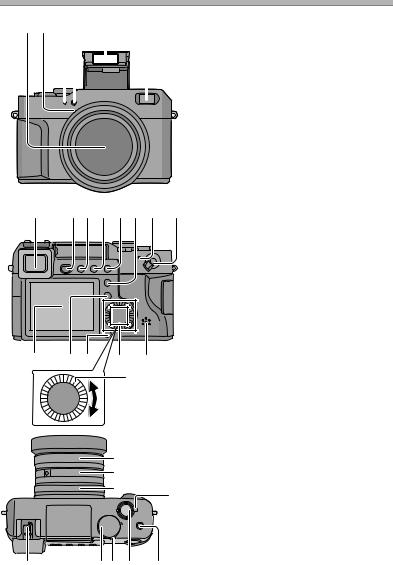
Preparation
Names of the Components
1 2 |
34 |
5 |
6 |
||||
|
|
|
|
|
|
|
|
|
|
|
|
|
|
|
|
|
|
|
|
|
|
|
|
|
|
|
|
|
|
|
|
7 8 9 10111213 14
15 |
16 17 |
18 |
19 |
|
|
20 |
|
1Lens
2Microphone (P59, P69)
3White Balance Sensor
4Self-timer Indicator (P49)
5Flash
6AF Sensor
7Viewfinder (P26)
8Flash Open Button (P44)
9[EVF/LCD] Button (P26)
10[DISPLAY] Button (P26)
11Exposure Compensation (P47)/Auto Bracket (P48)/Flash Output Adjustment (P45) Button
12[FUNCTION] Button (P60)
13Power Indicator (P22, P35)
14Camera Switch (P22, P34)
15LCD Monitor (P26, P111)
16[MENU] Button (P22)
17Delete Button (P55)
18Cursor Buttons 3/Self-timer Button (P49) 4/REVIEW Button (P42) 2 Button
1 Button
19Speaker (P76)
20Command Dial
|
|
21 |
Zoom Ring (P43) |
|
21 |
22 |
Focus Ring (P34, P40) |
|
23 |
Aperture Ring (P30) |
|
|
22 |
||
|
24 |
Metering Mode Dial (P29) |
|
|
23 |
25 |
Hot Shoe (P105) |
|
24 |
26 |
Shutter Speed Dial (P30) |
|
|
27 |
Operational Mode Dial (P29) |
|
|
28 |
Shutter Button (P34) |
|
|
29 |
Flash Button (P44) |
25 |
2627 28 29 |
|
|
7

30 31 |
32 |
 33
33

 34
34
35
36
Preparation
30Focus Ring Button (P34, P40)
31Aperture Ring Button (P30)
32Diopter Adjustment Dial (P27)
33[USB] Socket (5pin) (P97)
34[DC IN] Socket (P13)
35[AV OUT/REMOTE] Socket (P94)
36Terminal Door
37 

 38 39
38 39 
37Strap Eyelet (P19)
38Card Slot (P15)
39Card Door (P15)
40Battery Door (P11)
41Battery Door Open/Close Lever (P11)
42Tripod Receptacle
PENO
ESOLC
40 41 |
42 |
|
|
ª Battery Charger/AC Adaptor |
|
2 |
1 |
(P9, P13) |
3 |
1 |
[AC IN] Terminal |
2 |
Battery Attachment Part |
|
4 |
3 |
[POWER] Indicator |
5 |
4 |
[CHARGE] Indicator |
5 |
[DC OUT] Terminal |
|
8
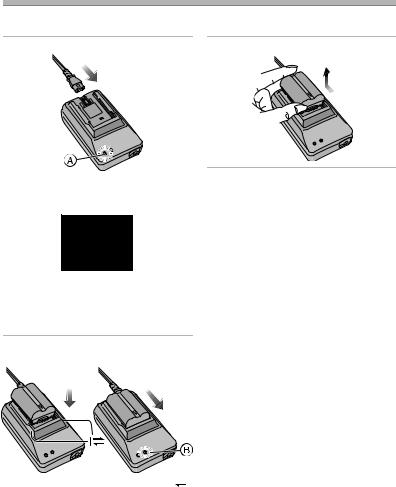
Preparation
Charging the Battery
Charge the battery before using.
1 Connect the AC cable.
•The AC cable does not fit entirely into the AC input terminal. A gap will remain as shown below.
•The [POWER] indicator A lights.
•The battery cannot be charged when the DC cable is connected to the AC adaptor.
2Attach the battery to the AC adaptor.
•Put the battery along the mark 
 horizontally and slide the battery.
horizontally and slide the battery.
•When the [CHARGE] Indicator B lights, charging starts.
•When the [CHARGE] indicator B turns off (in about 110 minutes), charging is finished.
3 Detach the battery.
¬Suggestions/Tips ¬
•After use, be sure to disconnect the AC cable.
•The battery becomes warm after use/ charge or during charge. The camera also becomes warm during use.
However, it is not a malfunction.
•The battery and AC adaptor are designed only for this camera. Do not use them with any other equipment.
•Do not disassemble or alter the AC adaptor.
•The battery cannot be charged in the camera with the AC adaptor connected.
9

Preparation
About the Battery
ª Battery indication
The remaining battery power appears on the screen. (This does not appear when using AC adaptor)
 >
>  >
>  >
>
(The indication turns red and blinks): Recharge or replace the battery.
ª Charging time and available recording time
Measured under the following conditions:
•Temperature: 25°C/Humidity: 60%
•Recording once every 30 seconds, flash every other record.
•Using the battery (supplied) and 16 MB SD Memory Card (supplied) [Picture size: 2560k1920/Quality: Fine (When deleting all pictures after full use)]
|
Charging time |
Continuous recording/playback time |
|
|
(recordable number) |
||
|
|
||
|
|
Recording with LCD monitor |
|
|
|
Approx. 180 min. |
|
|
|
(equal to 360 still pictures) |
|
|
|
|
|
Supplied battery |
Approx. 110 min. |
Recording with Viewfinder |
|
Approx. 220 min. |
|||
|
|
||
|
|
(equal to 440 still pictures) |
|
|
|
|
|
|
|
Playback with LCD monitor |
|
|
|
Approx. 340 min. |
|
|
|
|
The recording time (recordable number) and playback time depend on the condition.
ª Charging environment and charging error
•Charge the battery under temperature of 10 – 35°C. (The battery should also be the same temperature.)
•When charging starts, the [CHARGE] indicator lights.
If the charging error occurs, the [CHARGE] indicator blinks at about 1 second cycles.
In this case, disconnect the AC adaptor from the electrical outlet, remove the battery and ensure both room and battery temperature are not too low or high and then charge it again.
If the problem persists, consult the dealer or your nearest servicentre.
•When the operating time of the camera becomes extremely short even if the battery is properly charged, the life of the battery may be expired. Buy a new battery.
•The performance of the battery may be temporarily deteriorated and the operating time may become shorter under low temperature such as skiing grounds.
10
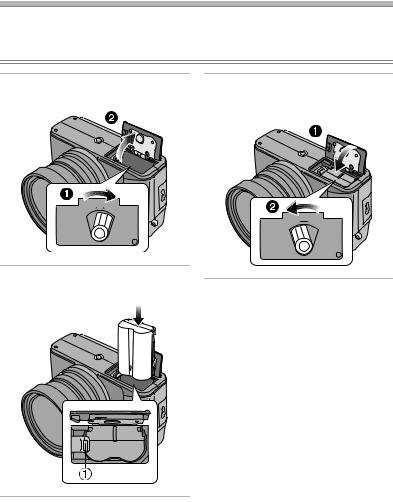
Preparation
Inserting the Battery
Preparation
• Check if the camera is turned off.
• Close the flash.
1 Slide the lever to open the battery |
3 Close the battery door and then |
door. |
slide the battery door open/close |
|
lever. |
CLOSE
OPEN
CLOSE
OPEN
2Insert the battery fully until the lock 1 pops on the battery.
11

Preparation
Removing the Battery
Preparation
• Check if the camera is turned off.
• Close the flash.
1 Slide the lever to open the battery |
3 Close the battery door and then |
door. |
slide the battery door open/close |
|
lever. |
CLOSE
OPEN
CLOSE
OPEN
2Push the lock 1 to remove the battery.
¬Suggestions/Tips ¬
•If you will not use the camera for a long time, remove the battery.
•After the fully charged battery has been inserted for more than 24 hours, the clock setting is stored (in the camera) for max. 3 months after the battery was removed, in accordance with the elapsed time after the battery is inserted. (The time may be shorter if the battery is not charged sufficiently.) If more than 3 months has passed, the clock setting will be lost. In this case, set the clock again. (P20)
•The supplied battery is designed only for this camera. Do not use it with any other equipment.
12
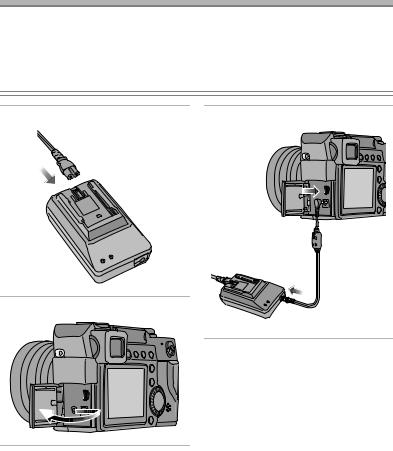
Preparation
Using the AC Adaptor
You can use the camera without worrying about battery discharge by connecting to an AC adaptor.
Preparation
•Check if the camera is turned off.
•Close the flash.
1 Connect the AC cable.
2 Slide the terminal door to open.
3 Connect the DC cable.
¬Suggestions/Tips ¬
•Use the supplied DC cable.
If you use other DC cables, it may cause a malfunction.
•The camera becomes warm during use. This is not a malfunction.
•Disconnect the AC adaptor and DC cable when the camera is not in use.
•The battery cannot be charged in the camera even if the AC adaptor is connected.
13
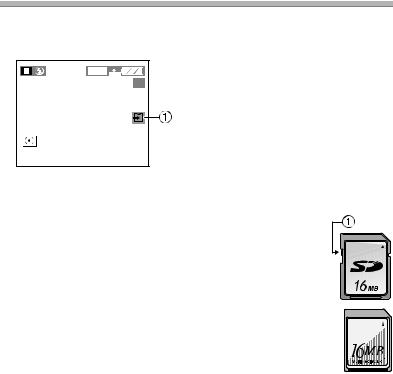
Preparation
About the Card
ª Access to the card
When the card is accessed, the card access indication 1 lights.
P |
|
2560 |
19
When the card access indication 1 lights, do not:
•turn the camera off.
•remove the battery or the card.
•disconnect the DC cable if you use the
AC adaptor.
The card and the data may be damaged and the camera may not operate normally.
ªSD Memory Card (supplied) and MultiMediaCard (optional)
The SD Memory Card and MultiMediaCard are small, lightweight, removable external memory cards. The reading/writing speed of an SD Memory Card is fast. The SD Memory Card is equipped with a Write-Protect switch 1 that can inhibit writing and formatting a card. (When the switch is slid to the [LOCK] side, it is not possible to write or delete data on the card and format it. When the switch is unlocked, these functions become available.)
SD Memory Card
It is possible that pictures stored on the card can be damaged due to accidental erasure, static electricity, electrical noise or a defective card. We recommend storing precious data to your PC’s hard drive. (P97)
MultiMediaCard
¬Suggestions/Tips ¬
•The reading/writing speed of a MultiMediaCard is slower than an SD Memory Card. When a MultiMediaCard is used, the performance of certain features may be slightly slower than advertised.
•After recording motion images using the MultiMediaCard, the card access indication may appear for a while, but this is not a malfunction.
•Keep the Memory Card out of reach of children to prevent swallowing.
14
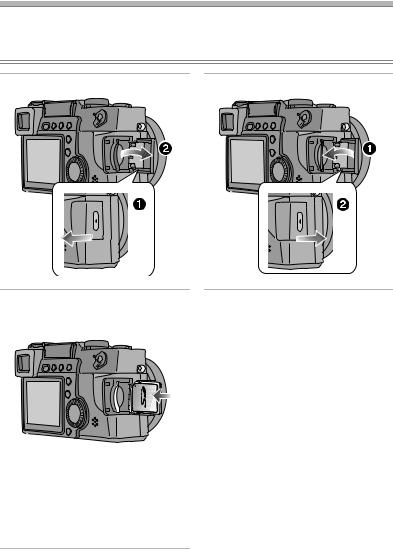
Preparation
Inserting the Card
Preparation
•Check if the camera is turned off.
•Close the flash.
1 Slide the card door to open.
3 Close and slide the card door.
2Insert the card with the label facing the rear of the camera until it clicks.
•Insert the card, pressing gently until it locks in place. If the card will not insert freely, it may be reversed. Do not force the card.
•Do not touch the connection terminals on the back side of the card.
15
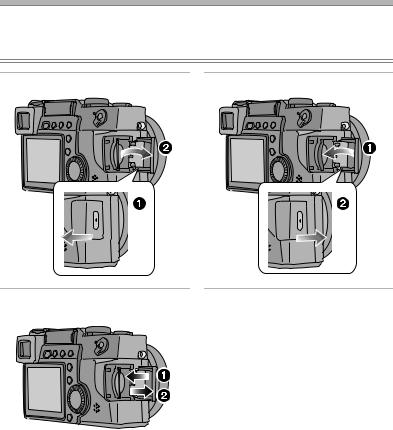
Preparation
Removing the Card
Preparation
•Check if the camera is turned off.
•Close the flash.
1 Slide the card door to open.
3 Close and slide the card door.
2Push the card until it clicks then pull the card out upright.
¬Suggestions/Tips ¬
•The card and the data may be damaged if it is removed while the camera is on.
•If the card door cannot be completely closed, remove the card and insert it again.
•If the card cannot be fully inserted, check the direction of the card.
•We recommend using Panasonic’s SD Memory Card. (Use only the genuine card.)
•The card may be damaged if it is not fully inserted.
•Do not open the card door during the access to the card. (P14)
16
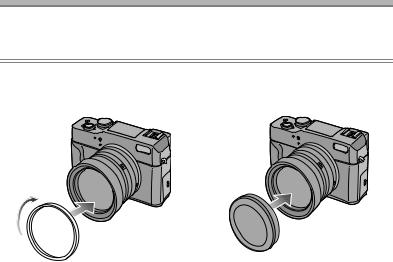
Preparation
Attaching the MC Protector/Lens Cap/Lens
Hood/Hood Cap
Preparation
• Check if the camera is turned off.
• Close the flash.
ª Attaching the MC Protector |
|
ª Attaching the lens cap |
|
|
|
1 Attach the MC protector. |
|
1 Attach the lens cap. |
•The MC protector is a transparent filter which affects neither the colours nor the amount of light, so it can always be used to protect the camera’s lens.
•You can also attach the lens hood.
•When you turn the camera off, carry the camera or play back the pictures, attach the lens cap to protect the surface of the lens.
•When using the MC protector, you can also attach the lens cap.
17
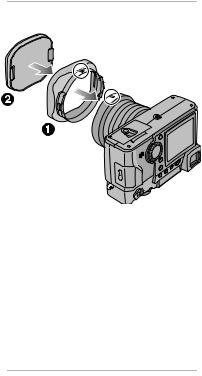
Preparation
ª Attaching the lens hood/hood cap
11 Attach the lens hood.
2 Attach the hood cap.
•The camera is turned upside down in the figure above.
•In bright sunlight or when there is backlight, the lens hood will minimize lens flare and ghosting.
•The lens hood cuts off excess lighting and improves the picture quality.
•When using the MC protector, you can also attach the lens hood.
•When detaching the lens hood, refer to P110.
¬Suggestions/Tips ¬
•If the MC protector is dropped, it may be damaged. Be careful not to drop it.
•Be careful not to lose the lens cap.
•You can also attach the ND filter (DMW-LND69; optional) by following the procedure for attaching the MC protector. The ND filter reduces the amount of light to approximately 1/8th (equal to adjusting the aperture value 3 increments) without affecting the colour balance.
•You cannot attach the MC protector and the ND filter at the same time.
•When attaching the lens hood, use the dedicated hood cap. You cannot use the lens cap.
•When taking pictures with flash, photo flash is interrupted by the lens hood and the bottom of the screen becomes dark. (vignetting effect)
•When taking pictures with flash, we recommend detaching the lens hood.
•When attaching the lens hood, attach the supplied hood cap on it. The lens cap cannot be attached on it.
•Consult the dealer or your nearest servicentre if you lose the supplied accessories. (You can purchase the accessories separately.)
18
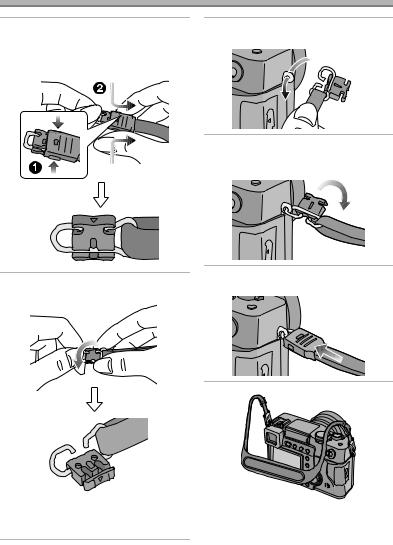
Preparation
Attaching the Strap
11 Pressing both sides of the cover.
2Pull out the black strap holder completely.
3Pass the metal fitting through the eyelet of the camera.
4Rotate the black strap holder in the opposite direction until it clicks.
2Detach the black strap holder from the metal fitting.
5Slide the cover until it is attached firmly.
•When the black strap holder is completely detached, attach it again as above.
•Attach the strap to the other side of the camera being careful not to twist it.
•Attach the strap so that you can see “LUMIX” logo.
•Check if the strap is firmly attached to the camera.
19
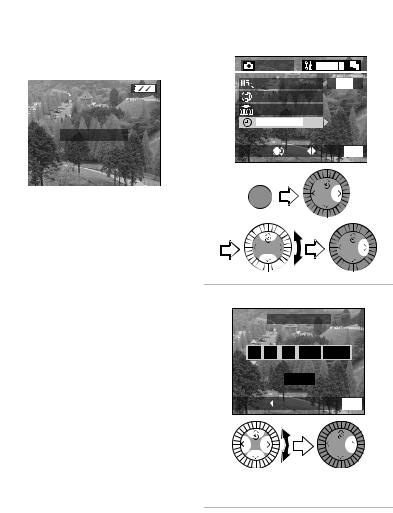
Preparation
Setting the Date/Time (Clock Set) |
|
|
|
|
|
|
|
|
|
|
|||||||||
|
|
|
|
|
|
|
|
|
|
|
|
|
|
|
|
|
|
|
|
ª Initial Use |
|
|
|
|
|
|
|
|
|
|
|
|
|
|
|||||
1 Select [CLOCK SET] from the |
|||||||||||||||||||
The clock is not set when the camera is |
|||||||||||||||||||
[SETUP] menu. (P22) |
|||||||||||||||||||
shipped. When you turn the camera on, |
|
|
|
|
|
|
|
|
|
|
|
|
|
|
|||||
the clock setting screen appears. |
|
|
REC |
|
|
|
|
|
|
|
|
|
|
||||||
|
|
|
2 |
||||||||||||||||
SETU |
|
P |
|
/ |
3 |
|
|
||||||||||||
|
|
|
|||||||||||||||||
|
|
|
|
|
|
|
|
|
|
|
|
|
|||||||
|
|
|
|
|
|
MF ASSIST |
|
|
|
||||||||||
|
|
|
|
|
|
|
MF1 |
||||||||||||
|
|
|
|
|
|
|
|
||||||||||||
|
|
|
|
|
|
|
CUSTOM SET. |
|
|
|
|
|
|
|
|
|
|
||
|
|
|
|
|
|
NO.RESET |
|
|
|
|
|
|
|
|
|
|
|||
|
PLEASE SET THE CLOCK |
|
|
|
|
|
|
|
|
|
|
|
|
|
|
|
|||
|
|
|
|
CLOCK SET |
|
|
|
|
|
|
|
|
|
|
|||||
|
|
|
|
|
|
|
|
|
|
|
|
|
|
|
|
|
|
|
|
|
|
|
|
|
|
|
|
|
|
|
|
|
|
|
|
||||
|
CLOCK SET |
MENU |
|
|
|
|
|
|
|
|
|
|
|
|
|
|
|
||
When pressing the [MENU] button, the screen shown in step 2 appears. Set the clock on it.
SELECT
 SET
SET EXIT MENU
EXIT MENU
MENU
REVIEW
REVIEW |
REVIEW |
2 Set date and time.
 CLOCK SET
CLOCK SET
10 :00 11. JAN . 2004 
D/M/Y
SELECT  SET
SET EXIT MENU
EXIT MENU
REVIEW |
REVIEW |
•2/1: Select the desired item.
•3/4: Set date and time.
20
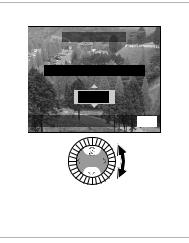
Preparation
3 Select [D/M/Y], [M/D/Y] or [Y/M/D].
 CLOCK SET
CLOCK SET
10:00111.JAN.2004
 D/M/Y
D/M/Y
SELECT SET
SET EXIT MENU
EXIT MENU
REVIEW
•Close the menu by pressing the [MENU] button 2 times after finishing the setting.
ªDate Printing
¬Suggestions/Tips ¬
•You can set the year from 2000 to 2099. The 24-hour system is used.
•After the fully charged battery has been inserted for more than 24 hours, the clock setting is stored (in the camera) for max. 3 months after the battery was removed, in accordance with the elapsed time after the battery is inserted. (The time may be shorter if the battery is not charged sufficiently.) If more than 3 months has passed, the clock setting will be lost. In this case, set the clock again.
•You can set the date printing in DPOF print setting on this camera. (P83)
•Using the supplied software, [SD Viewer for DSC], it is possible to have the date imprinted on the picture. For details, please read the supplied operating instructions for PC connection.
•When you ask photo studios for printing, be sure to order the printing of the date. For further information, ask a photo studio. Depending on the store, it may not be printed.
21
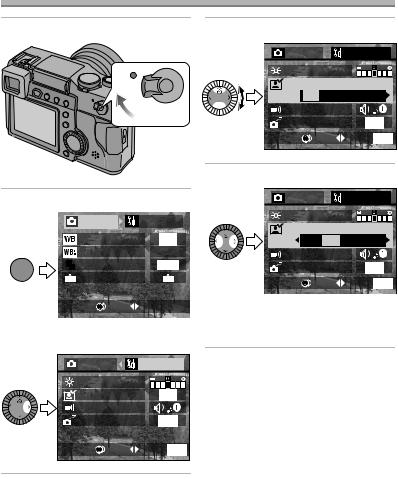
Preparation
Setup Menu
1 Turn the camera on.
ON
2 Press the [MENU] button.
|
|
|
REC |
1/4 |
SETUP |
||
|
|
|
W.BALANCE |
AUTO |
|||
MENU |
|
|
WB ADJUST. |
|
|
|
|
|
|
|
PICT.SIZE |
2560 |
|
||
|
|
|
|
||||
|
|
|
QUALITY |
|
|
|
|
|
SELECT |
SET |
EXIT |
|
|
||
|
MENU |
||||||
|
|
|
|
|
|
|
|
|
|
|
|
|
|
|
|
3 Select the [SETUP] Menu.
|
REC |
SETUP 1/3 |
|
MONITOR |
|
|
AUTO REVIEW |
OFF |
REVIEW |
BEEP |
|
|
POWER SAVE |
2MIN. |
|
SELECT SET |
EXIT MENU |
4 Select the desired item.
REC |
|
SETUP 1/3 |
MONITOR |
|
|
AUTO REVIEW |
|
|
OFF |
1SEC. 3SEC. ZOOM |
|
REVIEW |
|
|
BEEP |
|
|
POWER SAVE |
2MIN. |
|
SELECT |
SET |
EXIT MENU |
5 Set the desired value.
REC |
|
SETUP 1/3 |
MONITOR |
|
|
AUTO REVIEW |
|
|
OFF |
1SEC. 3SEC. ZOOM |
|
REVIEW |
|
|
BEEP |
|
|
POWER SAVE |
2MIN. |
|
SELECT |
SET |
EXIT MENU |
•Close the menu by pressing the [MENU] button after finishing the setting.
22
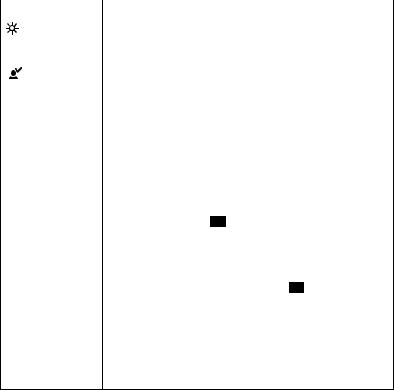
|
|
|
|
Preparation |
You can control the following items on [SETUP] menu. |
||||
|
|
|
|
|
|
|
|
Menu |
Functions |
|
|
|
MONITOR/ |
Adjust the brightness of the LCD monitor (when pictures |
|
|
|
FINDER |
appear on the LCD monitor) or Viewfinder (when pictures |
|
|
|
|
appear on the Viewfinder) in 7 steps. |
|
|
|
|
|
|
|
|
AUTO |
• [OFF]: The recorded picture does not automatically |
|
|
|
||
|
|
|
REVIEW°1 |
appear. |
•[1SEC.]: The recorded picture automatically appears on the screen for about 1 second.
•[3SEC.]: The recorded picture automatically appears on the screen for about 3 seconds.
•[ZOOM]: The recorded picture automatically appears on the screen for about 1 second. Then it is enlarged 4 times and appears for about
1 second. Pictures in burst mode, auto bracket, pictures with audio and pictures with setting the quality to [ RAW ] are not enlarged even if [ZOOM] is selected.
•In Motion image mode, auto review function is not activated.
•When pictures are recorded in burst mode, with auto bracket or with setting the quality to [ RAW ], the auto review function works while the card is recorded regardless of the setting on the auto review function. (The picture is not enlarged.)
•When using pictures with audio, the auto review function works while recording the audio or the data into the card regardless of the setting on the auto review function. (The picture is not enlarged.)
°1Recording mode only
23
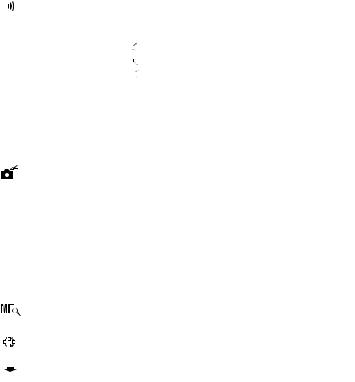
|
|
|
|
|
|
|
|
|
Preparation |
||||
|
|
|
|
|
|
|
|
|
|
|
|
|
|
|
|
|
|
|
Menu |
|
|
|
Functions |
||||
|
|
|
|
|
BEEP |
You can set [BEEP] and [SHUTTER] in the recording mode, |
|||||||
|
|
||||||||||||
|
|
||||||||||||
|
|
|
|
|
|
and [BEEP] in playback mode. |
|||||||
|
|
|
|
|
|
• Setting on [BEEP] (Setting on [BEEP] in recording mode) |
|||||||
|
|
|
|
|
|
• [ |
|
|
]: The operational sound turns high. |
||||
|
|
|
|
|
|
|
|||||||
|
|
|
|
|
|
• [ |
|
|
]: The operational sound turns low. |
||||
|
|
|
|
|
|
|
|||||||
|
|
|
|
|
|
• [ |
|
|
]: The operational sound turns off. |
||||
|
|
|
|
|
|
|
|||||||
|
|
|
|
|
|
• Setting on the shutter sound |
|||||||
|
|
|
|
|
|
• You can select the shutter sound from [ |
|
], [ |
|
] and |
|||
|
|
|
|
|
|
1 |
2 |
||||||
|
|
|
|
|
|
[ |
|
]. |
|
|
|
|
|
|
|
|
|
|
|
3 |
|
|
|
|
|||
|
|
|
|
|
|
• When the shutter speed is slower than 1/8, the shutter |
|||||||
|
|
|
|
|
|
sound beeps both times when the shutter is opened |
|||||||
|
|
|
|
|
|
and closed in recording. |
|||||||
|
|
|
|
|
|
|
|
|
|
|
|
|
|
|
|
|
|
|
POWER SAVE |
• [2MIN.]/[5MIN.]/[10MIN.]: |
|||||||
|
|
|
|
|
|
|
|
|
The camera is automatically turned off if it has not |
||||
|
|
|
|
|
|
|
|
|
been used for a predetermined amount of time. |
||||
|
|
|
|
|
|
|
|
|
(Press the shutter button or turn the camera off |
||||
|
|
|
|
|
|
|
|
|
and on to cancel the power save mode.) |
||||
|
|
|
|
|
|
• [OFF]: The camera is not automatically turned off. |
|||||||
|
|
|
|
|
|
• When using the AC adaptor/connecting to a PC/ |
|||||||
|
|
|
|
|
|
connecting to a printer/recording motion images/playing |
|||||||
|
|
|
|
|
|
back motion images/during Slide Show, the power save |
|||||||
|
|
|
|
|
|
mode is not activated. |
|||||||
|
|
|
|
|
|
|
|
|
|
|
|
|
|
|
|
|
|
|
MF ASSIST°1 |
In manual focus, assistance screen appears on the screen |
|||||||
|
|
|
|
|
|
to facilitate focusing on the subject. (P40) |
|||||||
|
|
|
|
|
|
|
|
|
|
|
|
|
|
|
|
|
|
|
CUSTOM |
Use this to set the menus which you want to include in the |
|||||||
|
|
|
|
|
SET.°1 |
FUNCTION menu. (P60) |
|||||||
|
|
|
|
|
NO.RESET°1 |
Set this when you want to start the file number of the next |
|||||||
|
|
|
|
|
|||||||||
|
|
|
|
|
|
picture from 0001. |
|||||||
|
|
|
|
|
|
(The folder number is renewed and the file number starts |
|||||||
|
|
|
|
|
|
from 0001.) |
|||||||
|
|
|
|
|
|
• The folder number can be assigned from 100 to 999. |
|||||||
|
|
|
|
|
|
When the folder number reaches to 999, it cannot be |
|||||||
|
|
|
|
|
|
reset. We recommend formatting the card after saving the |
|||||||
|
|
|
|
|
|
data on a PC or other. |
|||||||
|
|
|
|
|
|
|
|
|
|
|
|
|
|
°1 Recording mode only
24
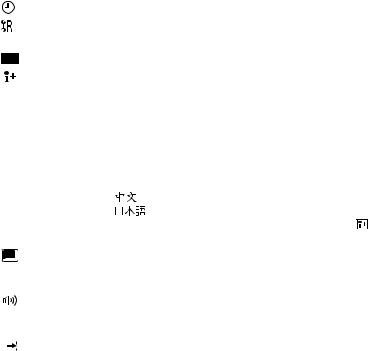
|
|
|
|
|
Preparation |
|
|
|
|
|
|
|
|
|
Menu |
|
Functions |
|
|
|
CLOCK SET |
Change the date and time. (P20) |
|
|
|
|
|
|
|
|
|
|
RESET°1 |
The camera is reset to the initial settings. However, the |
|
|
|
|
|
folder number and the clock settings are not changed. |
|
|
|
|
|
|
|
|
|
|
USB MODE |
Set before connecting to a PC or a printer. (P95) |
|
|
|
|
|
|
|
|
|
|
LANGUAGE |
Set to the language on the menu screen from the following |
|
|
|
|
|||
|
|
|
|
7 languages. |
|
|
|
|
|
Set to the desired language with 2/1 and determine it with |
|
|
|
|
|
4. |
|
|
|
|
|
• [ENGLISH]: The menu screen in English |
|
|
|
|
|
• [DEUTSCH]: The menu screen in German |
|
|
|
|
|
• [FRANÇAIS]: The menu screen in French |
|
|
|
|
|
• [ESPAÑOL]: The menu screen in Spanish |
|
|
|
|
|
• [ITALIANO]: The menu screen in Italian |
|
|
|
|
|
• [ |
]: The menu screen in Chinese (Simplified) |
|
|
|
|
• [ |
]: The menu screen in Japanese |
|
|
|
|
• When you set to other language by mistake, select [ ] |
|
|
|
|
|
from the menu icons to set the desired language. |
|
|
|
|
|
|
|
|
|
|
PLAY ON |
When Viewfinder is selected in the recording mode, the |
|
|
|
|
LCD°2 |
picture automatically appears on the LCD monitor in review |
|
|
|
|
|
or playback. (P27) |
|
|
|
|
|
|
|
|
|
|
VOLUME°2 |
The volume of speakers can be adjusted in 7 steps. |
|
|
|
|
|
• When you connect the camera to a TV, the volume of the |
|
|
|
|
|
speakers of the TV is not changed. |
|
|
|
|
|
|
|
|
|
|
VIDEO OUT°2 |
• [NTSC]: Video output is set to NTSC system. |
|
|
|
|
|||
|
|
|
|
• [PAL]: |
Video output is set to PAL system. (P94) |
|
|
|
|
|
|
°1 Recording mode only °2 Playback mode only
25
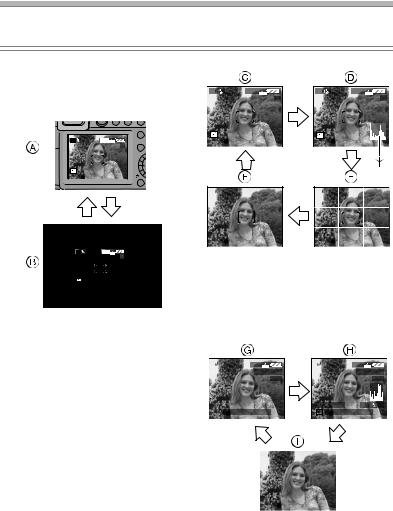
Preparation
Using the LCD Monitor/Viewfinder
The LCD monitor of the camera is easy to be viewed out of doors because the LCD monitor reflects sunlight to use it as a backlight.
ª Switching the screen to be turned In recording mode on
Press the [EVF/LCD] button to switch to the screen you would like to turn on.
P |
|
2560 |
|
P |
|
2560 |
|
|
19 |
|
19 |
||||
|
|
FUNCTION |
P |
2560 |
MENU |
19
P |
2560 |
19
A LCD monitor (LCD)
B Viewfinder (EVF)
•When the LCD monitor turns on, the Viewfinder turns off. (and vice versa)
ª Selecting the screen to be used
Press the [DISPLAY] button to switch the screen to be used.
•When the menu screen appears, during multi playback or during playback zoom, the [DISPLAY] button is not activated.
C Display
D Display with histogram
E Nondisplay (Recording guide line) F Nondisplay
¢Histogram
In playback mode
|
|
|
2560 |
0_0001 |
|
|
|
|
|
|
2560 |
0_0001 |
||
|
|
|
10 |
|
|
|
|
|
|
10 |
||||
|
|
1/19 |
|
|
|
|
|
1/19 |
||||||
|
|
|
|
|
|
|
|
F2.8 1/25 |
|
|
|
|||
|
|
|
|
|
P |
|
|
ISO100 |
AUTO |
|||||
10:00 |
1.JAN.2004 |
|
|
10:00 |
1.JAN.2004 |
|||||||||
|
||||||||||||||
|
|
|
|
|
|
|
|
|
|
|
|
|
|
|
|
|
|
|
|
|
|
|
|
|
|
|
|
|
|
G Display
H Display with recording information and histogram
I Nondisplay
26
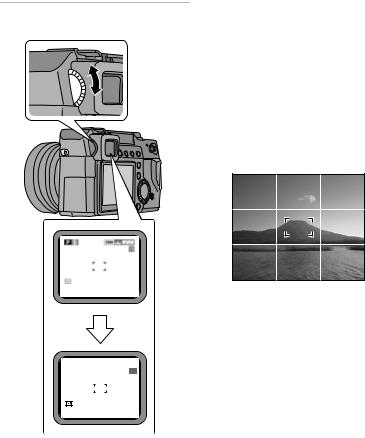
Preparation
ª Diopter adjustment
This feature is useful for users who wear corrective lenses and prefer to use the Viewfinder.
Preparation
•Press the [EVF/LCD] button to display the Viewfinder.
1Adjust the diopter, rotating the diopter adjustment dial.
ª Monitor priority
When setting [PLAY ON LCD] (P25) to [ON] on the [SETUP] menu, the LCD monitor is turned on in the following cases.
You can save the time to switch the display to the LCD monitor even when using the Viewfinder in recording.
•When the recording mode is switched to playback mode
•When reviewing pictures (P42)
•When turning the camera on in playback mode
ª Recording guide line
You can achieve balanced pictures by aligning the subject on the cross point of the horizontal and vertical guide lines. You can also take pictures easily by adjusting the horizon to the guide line.
You can take pictures with well-designed composition by watching the size and the balance of subjects.
P |
|
|
2560 |
|
19
27
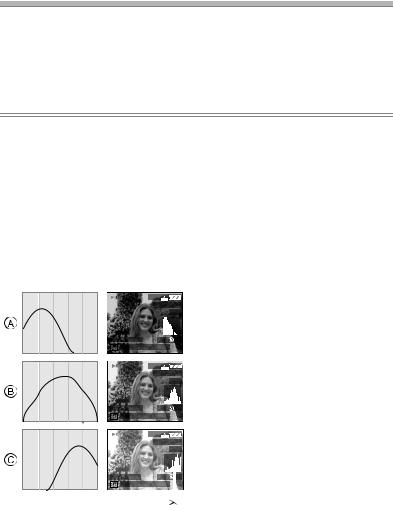
Preparation
About the Histogram
•A histogram is a graph that displays brightness along the horizontal axis (black to white) and the number of pixels at each brightness level on the vertical axis.
•It allows the camera user to easily check the way a picture is being exposed.
•It is very useful if manual adjustments of the lens aperture and shutter speed are available, especially in those situations where automatic exposure may be difficult due to uneven lighting. Using the histogram feature will allow you to get the best performance from the camera.
•When the values are concentrated to the left as A, the picture is under exposed.
•When the values in the histogram are distributed as B, the exposure is adequate and the brightness is well-balanced.
•When the values are concentrated to the right as C, the picture is over exposed.
ª Example of histogram
|
|
|
|
|
|
|
|
|
|
2560 |
0_0001 |
|||||
|
|
|
|
|
|
|
|
|
|
10 |
||||||
|
|
|
|
|
|
|
|
|
|
1/19 |
||||||
|
|
|
|
F2.8 1/200 |
|
|
|
|
|
|||||||
|
|
P |
|
ISO100 |
|
AUTO |
||||||||||
|
|
|
10:00 |
1.JAN.2004 |
|
|
||||||||||
|
|
|
|
|
||||||||||||
|
|
|
|
|
|
|
|
|
|
|
|
|
|
|
|
|
|
|
|
|
|
|
|
|
|
|
2560 |
|
0_0001 |
||||
|
|
|
|
|
|
|
|
|
|
10 |
|
|||||
|
|
|
|
|
|
|
|
|
|
1/19 |
||||||
|
|
|
|
|
|
|
F2.8 1/100 |
|
|
|
|
|
|
|||
|
P |
|
ISO100 |
|
AUTO |
|||||||||||
|
|
|
|
10:00 |
1.JAN.2004 |
|
|
|||||||||
|
|
|
|
|
|
|||||||||||
|
|
|
|
|
|
|
|
|
|
|
|
|
|
|
|
|
|
|
|
|
|
|
|
|
|
|
2560 |
|
|
0_0001 |
|||
|
|
|
|
|
|
|
|
|
|
10 |
||||||
|
|
|
|
|
|
|
|
|
|
|
|
|
|
|
1/19 |
|
|
|
|
|
|
|
F2.8 1/50 |
|
|
|
|
|
|||||
|
|
|
|
|
|
|
|
|
|
|
|
|
|
|
||
|
|
P |
|
|
ISO100 |
|
AUTO |
|||||||||
|
|
10:00 |
1.JAN.2004 |
|
|
|||||||||||
|
|
|
||||||||||||||
|
|
|
|
|
|
|
|
|
|
|
|
|
|
|
|
|
¬Suggestions/Tips ¬
•When the recorded picture and the histogram do not match each other under the following conditions, the histogram is displayed in yellow.
–When the flash is activated
–When the flash is closed
•When the brightness of the screen is not correctly displayed in dark places
•When the exposure is not adequately adjusted in dark places
•The histogram does not appear when in Motion image mode, during multi playback and playback zoom.
•The histogram in recording and playback may not match each other.
•The histogram in this camera does not match the one displayed in image editing software on PC, etc.
•The histogram in the recording mode is an approximation.
A Under Exposed B Properly Exposed C Over Exposed ¢Histogram
28
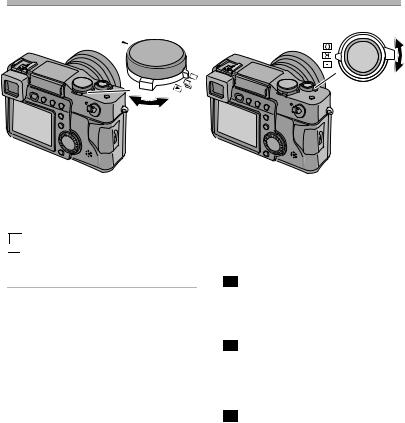
Preparation
Operational Mode Dial and Metering Mode Dial
ª Operational mode dial |
ª Metering mode dial |
You can switch to the recording mode (single/burst) and the playback mode.
: Single mode (P34)
 : Burst mode (P50)
: Burst mode (P50)
 : Playback mode (P51)
: Playback mode (P51)
You can switch to the following metering methods.
Metering |
Details of setting |
||
mode |
|
||
|
|
|
|
|
|
This evaluates the |
|
[ |
] |
whole of the screen |
|
Multiple |
and optimizes the |
||
|
|
exposure. |
|
|
|
|
|
|
|
This evenly evaluates |
|
[ |
] |
the whole of the |
|
Centre |
screen pointing to the |
||
weighted |
subject on the centre |
||
|
|
of the screen. |
|
|
|
|
|
[ |
] |
This evaluates the |
|
subject on the spot |
|||
Spot |
|||
metering target. |
|||
|
|
||
|
|
|
|
29
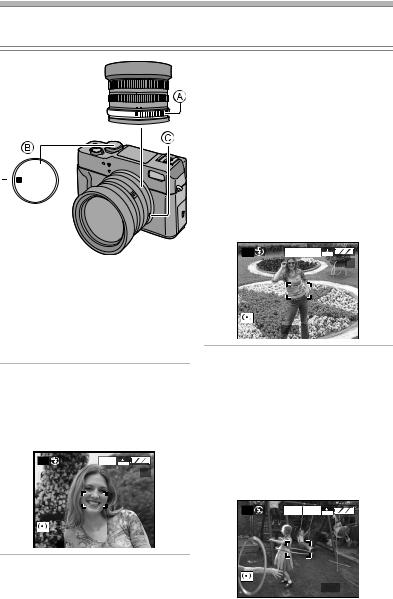
Preparation
Setting the AE mode
You can set the AE mode (AE: Auto Exposure) by setting the aperture ring and the shutter speed dial.
|
90 75 |
|
|
50 |
|
|
35 |
28 [ 35mm EQIV. ] |
|
|
3.2 |
4 |
6 |
2 |
10 |
25 |
|
AF AF-Macro |
|
|
|
1.2 |
|
3 |
8 |
|
|||
2 |
2.8 |
4 |
|
5.6 |
8 |
11 |
A |
|
|
|
|
|
|||||||
|
4 |
8 |
15 |
|
2 |
|
|
|
30 |
– |
|
|
|
|
A |
8s |
|
|
60 |
|
|
|
||
2000 |
500 |
|
125 |
|
|
1000 |
250 |
||
A: the aperture ring
B: the shutter speed dial
C: the aperture ring button
•When adjusting the aperture ring to [A] or changing the position from [A] to other, rotate the aperture ring with pressing the aperture ring button C.
ª Programme AE mode [  ]
]
The exposure is automatically set by the camera.
Adjust the aperture ring and the shutter speed dial to [A].
P |
2560 |
19
ª Aperture-priority AE mode [ ]
]
When you want the background to be in sharp focus, set the aperture value to a higher number. The higher the aperture value, the smaller the aperture opening will be. For a soft focus background, set the aperture number to a lower number which corresponds to a larger aperture opening.
The shutter speed is changed according to the aperture value.
Adjust the aperture ring between 2 and 11, and the shutter speed dial to [A].
A |
ISO100 |
2560 |
19
F2.8
ª Shutter-priority AE mode [ ]
]
When you want to take a sharp picture of a fast moving subject, set to faster shutter speed. When you want to create a trail effect, set to slower shutter speed. The aperture value is changed according to the shutter speed.
Adjust the aperture ring to [A] and the shutter speed dial between 2000 and 2–8s.
S |
ISO100 |
2560 |
19
1/30
30
